Sumatran Rhino in Indonesia is Pregnant! Rhino born at the Cincinnati Zoo is the Father

CINCINNATI (September 22, 2015) – The International Rhino Foundation (IRF) announced today, on World Rhino Day, that the critically-endangered Sumatran rhino population will soon increase by one. In a species with fewer than 100 individuals left on the planet, one is a significant number.
The announcement has special local significance since the father, Andalas, was born at the Cincinnati Zoo & Botanical Garden. His birth, in 2001, was the result of a scientific breakthrough by the Zoo’s Center for Conservation & Research of Endangered Wildlife (CREW) and held the distinction of being the first Sumatran rhino in human care birth in 112 years! This will be the second calf that Andalas has sired since his arrival at the Sumatran Rhino Sanctuary (SRS) in 2007. The first calf, Andatu, was born to female Ratu in 2012 and made history as the first Sumatran rhino calf produced in zoos in Indonesia.
“This news couldn’t come at a better time,” said Dr. Terri Roth, Vice President of Conservation and Science and Director of CREW. “To have a successful breeding confirmed at the SRS weeks before we hope to send Andalas’ younger sibling, Harapan, to the sanctuary for the same purpose is encouraging and fuels the hope that Harapan will also contribute to the survival of his species.”

The Cincinnati Zoo recently announced that eight-year-old Harapan, the last Sumatran rhino in the western hemisphere, will be moving from Cincinnati to Indonesia this fall. His departure marks the end of an era for the Cincinnati Zoo’s Sumatran rhino breeding program, one that for a decade was the only zoo breeding program in the world producing calves for this crtically-endangered species.
CREW will continue to lend support to the breeding program at the SRS. Dr. Roth was in Indonesia working daily with the staff at the SRS in January when Ratu mated with Andalas for the first time since becoming pregnant with Andatu in 2011. Pregnancy was confirmed by the SRS veterinarian, Dr. Zulfi, during an ultrasound exam 17 days later. However, given the susceptibility of this species to early pregnancy loss, the news was kept under wraps until Ratu was mid-way through her pregnancy. Ratu has been administered a daily hormone supplement based on the protocol developed by CREW scientists to overcome early pregnancy loss in the Zoo’s previous breeding female rhino, Emi. Additionally, the vets and keepers at the sanctuary have been monitoring Ratu’s pregnancy by weighing her weekly and conducting regular ultrasound exams.
Ultrasound images of the developing calf, shown here, indicate that the pregnancy is progressing normally. The gestation period for a Sumatran rhino is 16 months, making Ratu’s due date May, 2016.

About the Sumatran Rhino Breeding Program at the Cincinnati Zoo
After years of research, CREW scientists at the Cincinnati Zoo, led by Dr. Roth, unraveled the mysteries of Sumatran rhino reproduction and, in 2001, produced Andalas, the first calf bred and born in zoos in 112 years. In 2004, his sister, Suci, was born, and in 2007, Harapan arrived. Between 2001 and 2012, the Cincinnati Zoo held the distinction as the only place successfully breeding this endangered species. The Zoo worked closely with Indonesian and Malaysian colleagues to transfer knowledge and techniques so that they too could succeed. In 2007, the Cincinnati and Los Angeles Zoos agreed to send Andalas to the SRS to replace an old, infertile bull. That sacrifice on the part of the LA Zoo, where Andalas was living at the time of his transfer, paid off in spades in 2012 when Andalas’s healthy son was born in Sumatra.
The Cincinnati Zoo works closely with the Indonesian Ministry of Forestry, the Indonesian Rhino Foundation, the IUCN Asian Rhino Specialist Group and the International Rhino Foundation, to protect this species in the wild and also propagate Sumatran rhinos in zoos.
VIDEO: Watch the New Baby’s Ultrasound
PHOTOS: See Ultrasound Images of the Baby’s Growth
PHOTOS: See Images of the Baby’s Older Brother As a Newborn

